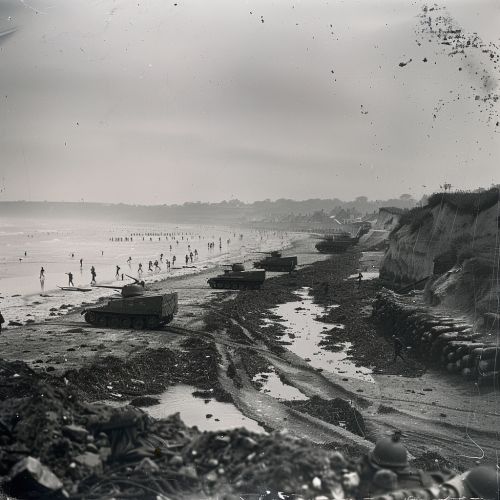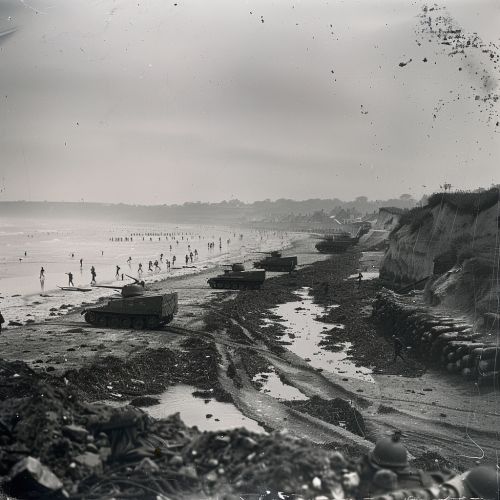D-Day: Difference between revisions
(Created page with "== Background and Planning == D-Day, officially termed Operation Overlord, was the Allied invasion of Normandy during World War II. This military operation commenced on June 6, 1944, and marked a pivotal turning point in the conflict. The operation was meticulously planned and executed by the Allied forces, which included the United States, the United Kingdom, Canada, and other Allied nations. The primary objective was to establish a foothold in continental Europe and b...") |
No edit summary |
||
| Line 23: | Line 23: | ||
Omaha Beach presented the most formidable challenges. The U.S. 1st and 29th Infantry Divisions faced intense German resistance, with heavy casualties incurred during the initial landings. The rough terrain and well-fortified German positions made progress slow and costly. However, through sheer determination and the support of naval gunfire, the American forces eventually secured Omaha Beach by the end of the day. | Omaha Beach presented the most formidable challenges. The U.S. 1st and 29th Infantry Divisions faced intense German resistance, with heavy casualties incurred during the initial landings. The rough terrain and well-fortified German positions made progress slow and costly. However, through sheer determination and the support of naval gunfire, the American forces eventually secured Omaha Beach by the end of the day. | ||
[[Image:Detail-97311.jpg|thumb|center|Normandy beach with Allied troops landing and moving inland.|class=only_on_mobile]] | |||
[[Image:Detail-97312.jpg|thumb|center|Normandy beach with Allied troops landing and moving inland.|class=only_on_desktop]] | |||
=== Gold Beach === | === Gold Beach === | ||
Latest revision as of 14:05, 27 July 2024
Background and Planning
D-Day, officially termed Operation Overlord, was the Allied invasion of Normandy during World War II. This military operation commenced on June 6, 1944, and marked a pivotal turning point in the conflict. The operation was meticulously planned and executed by the Allied forces, which included the United States, the United Kingdom, Canada, and other Allied nations. The primary objective was to establish a foothold in continental Europe and begin the liberation of Nazi-occupied territories.
The planning for D-Day began in earnest in 1943 under the direction of General Dwight D. Eisenhower, the Supreme Commander of the Allied Expeditionary Force. The operation required extensive coordination and secrecy to ensure its success. The Allies employed a range of deceptive tactics, collectively known as Operation Bodyguard, to mislead the Germans about the invasion's timing and location.
The Invasion Forces
The invasion force comprised several distinct components, including airborne divisions, naval forces, and ground troops. The airborne divisions, consisting of the U.S. 82nd and 101st Airborne Divisions and the British 6th Airborne Division, were tasked with securing key positions inland to disrupt German reinforcements and protect the flanks of the landing beaches.
The naval forces, under the command of Admiral Sir Bertram Ramsay, included over 5,000 ships and landing craft. This armada was responsible for transporting the ground troops across the English Channel and providing naval gunfire support during the landings.
The ground troops were divided into five beachheads: Utah, Omaha, Gold, Juno, and Sword. Each beachhead was assigned to different Allied nations, with the U.S. forces landing at Utah and Omaha, the British at Gold and Sword, and the Canadians at Juno.
The Landings
The landings on June 6, 1944, began with a massive aerial and naval bombardment to soften German defenses. At approximately 06:30, the first waves of infantry began to land on the beaches. The conditions were challenging, with rough seas and strong German fortifications posing significant obstacles.
Utah Beach
The U.S. 4th Infantry Division landed at Utah Beach, encountering relatively light resistance. The effective use of amphibious tanks and pre-landing bombardments contributed to the success at Utah Beach. By the end of the day, the 4th Infantry Division had secured a beachhead and linked up with airborne units inland.
Omaha Beach
Omaha Beach presented the most formidable challenges. The U.S. 1st and 29th Infantry Divisions faced intense German resistance, with heavy casualties incurred during the initial landings. The rough terrain and well-fortified German positions made progress slow and costly. However, through sheer determination and the support of naval gunfire, the American forces eventually secured Omaha Beach by the end of the day.


Gold Beach
The British 50th Infantry Division landed at Gold Beach, encountering moderate resistance. The use of specialized armored vehicles, known as Hobart's Funnies, helped overcome obstacles and clear paths for the infantry. By the end of the day, the British forces had secured Gold Beach and advanced inland.
Juno Beach
The Canadian 3rd Infantry Division faced strong resistance at Juno Beach, with heavy casualties during the initial landings. Despite these challenges, the Canadian forces managed to secure the beachhead and advance inland, linking up with British forces from Gold Beach.
Sword Beach
The British 3rd Infantry Division landed at Sword Beach, encountering stiff resistance from German forces. The use of specialized tanks and pre-landing bombardments helped the British forces overcome these obstacles. By the end of the day, the British had secured Sword Beach and linked up with airborne units inland.
Aftermath and Impact
The success of the D-Day landings marked the beginning of the end for Nazi Germany. The establishment of a foothold in Normandy allowed the Allies to bring in reinforcements and supplies, leading to the eventual liberation of France and the defeat of German forces in Western Europe.
The operation demonstrated the effectiveness of combined arms operations and the importance of meticulous planning and coordination. The lessons learned from D-Day have continued to influence military strategy and operations in the decades since.
